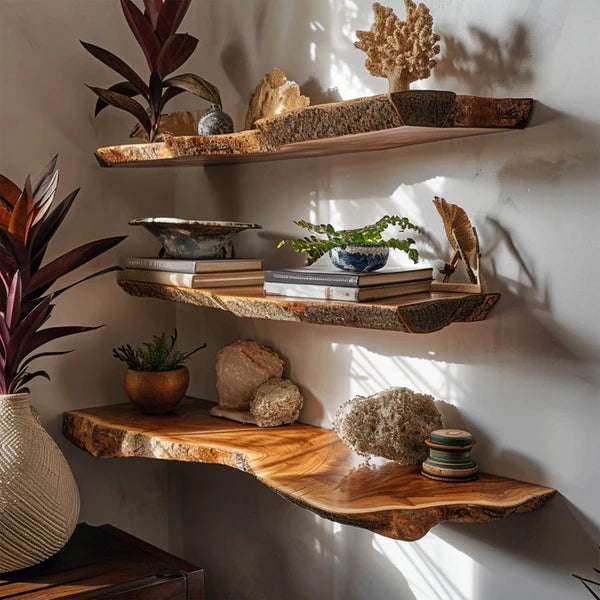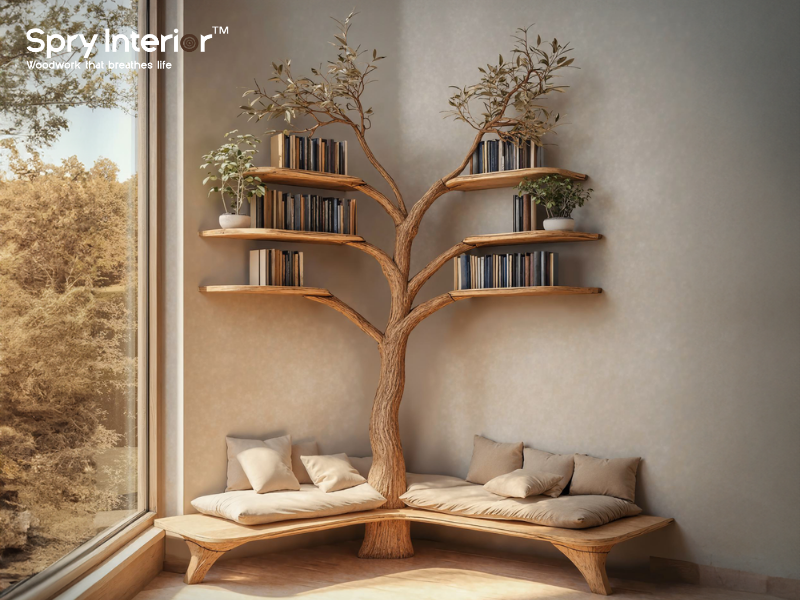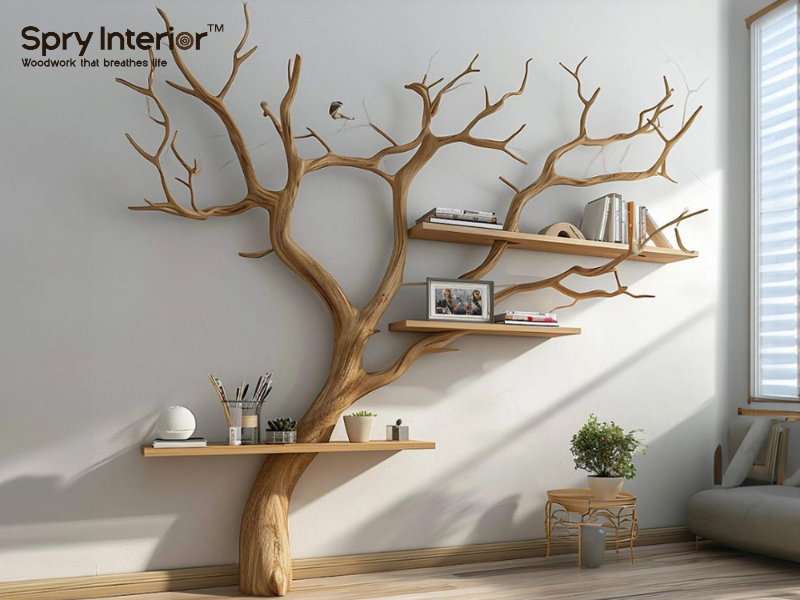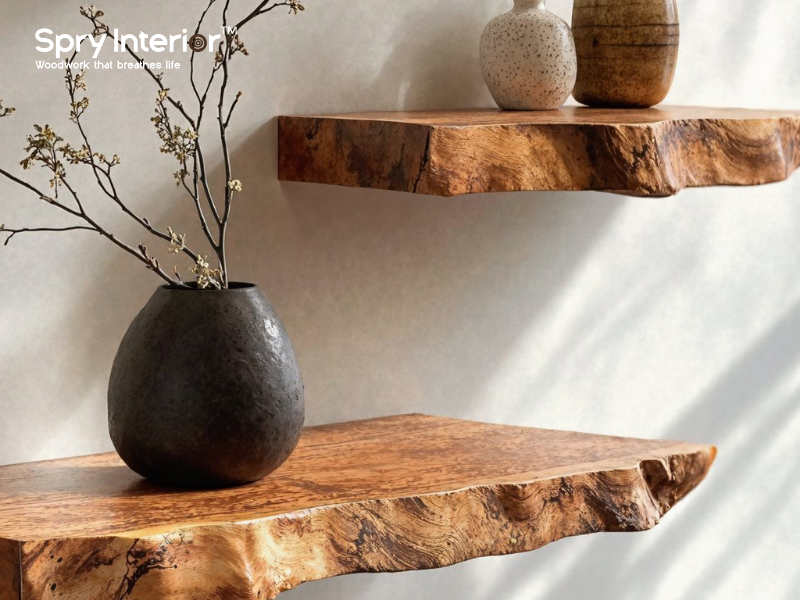When exploring what makes a Montessori bookshelf?, it's essential to understand the philosophy behind Montessori education itself. A Montessori bookshelf isn't just a regular piece of furniture; it's intentionally designed to nurture a child's independence, curiosity, and love for reading from an early age. By carefully selecting materials, designing the structure to match a child's developmental stages, and arranging books in a visually accessible manner, Montessori shelves uniquely foster autonomy and self-directed learning. In this detailed guide, we will delve deeper into the essential characteristics of Montessori bookshelves, considerations on how to make a tree bookshelf, the popular question of Is it cheaper to buy or build a bookshelf?, and even discuss creative ideas like How to make a stacked book tree?. Additionally, we'll explore why choosing SpryInterior's Tree Bookshelf could be the perfect fit for your home.
Essential Features of a Montessori Bookshelf
Montessori bookshelves differ significantly from traditional shelves. They aren't merely storage units but carefully crafted spaces that encourage children to interact independently with their environment. Several key features make these shelves uniquely Montessori-oriented.
Wood Bookshelf Tree | Tree Bookcase Assembly Tutorial | 2025 Living Room Ideas
Child-Level Accessibility
A primary characteristic of Montessori shelves is their height and ease of access. Bookshelves in the Montessori tradition are low and positioned at the child’s eye-level, allowing kids to freely explore and choose books on their own. This empowers children, promotes independence, and encourages a genuine interest in reading. The accessibility aspect fosters confidence and self-directed learning because children don’t need adult assistance to engage with their favorite books or educational materials.

Open and Minimalist Design
Another distinctive attribute is the simplicity and openness of design. Montessori shelves usually avoid doors, lids, or complicated barriers that might discourage a child's curiosity. The minimalist style helps prevent overstimulation, as clutter can easily distract children. A Montessori bookshelf is typically constructed with clean lines, open compartments, and simple shelves to clearly display book covers. This clean visual layout invites exploration and promotes concentration.

Natural and Safe Materials
Montessori principles emphasize the use of natural materials that are safe, sustainable, and sensory-rich. Wooden shelves made from non-toxic, smooth-finished wood are especially favored due to their tactile qualities and connection to nature. The texture and warmth of wood invite children to interact closely with their surroundings. Durability and sturdiness are also prioritized to ensure children can safely use the bookshelf independently without risk of tipping or injury.

Montessori Bookshelf Organization: Encouraging Independence and Interest
How books are arranged is equally as critical as the shelf's physical characteristics. Montessori philosophy encourages displaying books thoughtfully to inspire children’s natural curiosity and engagement.
Front-Facing Books Display
In traditional shelves, books are often stacked side by side, showing only their spines. Montessori bookshelves, however, typically showcase books front-facing, allowing children to immediately see cover illustrations. This visual accessibility not only sparks interest but also enables younger children, who cannot yet read, to select books based on attractive imagery. The covers act as visual invitations, drawing children towards the books and cultivating an early love of reading.

Rotating Book Selection
Regularly rotating the selection of books available on a Montessori shelf ensures continuous engagement and helps maintain children's attention. A limited selection, typically around six to ten books, displayed at a time prevents overwhelm and encourages deeper interaction with each title. Rotating the books weekly or bi-weekly keeps the reading experience fresh and stimulating, fueling excitement and curiosity for each new rotation.
Categorizing Books by Themes or Interests
Arranging books by specific themes, such as nature, animals, seasons, or daily routines, supports children in exploring and understanding the world around them. Categorization also helps kids independently find books based on their interests, boosting their sense of autonomy. Montessori shelves may group related books together, fostering thematic exploration, conversation, and deeper understanding.
Creative Montessori-Inspired Bookshelf Designs
While the classic Montessori bookshelf is minimal and straightforward, integrating creative, nature-inspired designs like a tree bookshelf or stacked book tree can enrich your child's reading environment and stimulate imagination.
How to Make a Tree Bookshelf: Nature Meets Montessori
If you're considering how to make a tree bookshelf, it’s important to maintain Montessori principles, including accessibility and open design. A tree bookshelf mimics the branches and trunk of a tree, serving as an exciting visual element that connects children with nature. Choose smooth, sustainably sourced wood, carefully sanding and finishing each component. The shelves or branches should remain low and easily reachable by children, keeping the Montessori method's child-centered approach intact.

How to Make a Stacked Book Tree: Balancing Creativity and Functionality
Learning How to make a stacked book tree? involves creating a vertical shelving structure resembling a stylized pine tree, where books rest flat upon tiered horizontal platforms. To align with Montessori philosophy, ensure these stacked shelves remain within a child's comfortable reach, promoting independence. Such a design can also subtly teach organizational skills and spatial reasoning, as children learn to stack books safely and aesthetically, encouraging tidiness through play.

Is It Cheaper to Buy or Build a Bookshelf?
A frequently asked question among parents is, Is it cheaper to buy or build a bookshelf?. Building a custom Montessori shelf can offer substantial savings, especially if you possess basic woodworking skills or have access to affordable materials. However, if high-quality materials or intricate designs are required, building your own shelf might become more expensive. Additionally, consider the time investment and necessary tools when deciding whether purchasing or crafting a Montessori shelf is more economical. For many busy families, purchasing a ready-made shelf often proves more convenient, cost-effective, and time-saving in the long run.
Why Choose SpryInterior for Your Montessori Bookshelf?
While Montessori shelves are widely available, SpryInterior offers uniquely crafted options specifically designed with Montessori principles in mind, particularly through their signature SpryInterior's Tree Bookshelf.
Expert Montessori-Centric Design
SpryInterior specializes in furniture created explicitly around Montessori principles, ensuring that every shelf promotes independence, accessibility, and visual engagement. The careful attention to child-friendly heights, safe and open designs, and attractive presentation directly align with Montessori ideals. The intentional craftsmanship behind each bookshelf reflects SpryInterior’s commitment to supporting children's developmental growth through thoughtfully designed environments.

High-Quality, Safe, and Sustainable Materials
At SpryInterior, quality and safety are paramount. Each shelf is meticulously handcrafted using sustainably sourced, non-toxic materials, ensuring longevity and safety. The tactile beauty of natural wood enhances the Montessori learning environment, enriching the sensory experience for children. Parents can trust that these shelves not only look attractive but also offer lasting durability and peace of mind.

Innovative Tree Bookshelf Designs
SpryInterior excels in creatively designed tree bookshelves, combining the essence of nature with Montessori's practical philosophy. Their shelves capture children's imagination, fostering a deeper connection to reading through the organic shapes and structures of trees. The innovative, playful designs simultaneously inspire creativity and reinforce independence, providing children with an engaging environment that extends beyond simple book storage.
Conclusion
In understanding what makes a Montessori bookshelf?, it’s clear that thoughtful design, natural materials, accessibility, and visual appeal play crucial roles in fostering independence and a lifelong love of reading in children. Whether you're exploring how to make a tree bookshelf, weighing Is it cheaper to buy or build a bookshelf?, or planning How to make a stacked book tree?, integrating Montessori principles remains essential. Among many available options, choosing SpryInterior's Tree Bookshelf ensures you receive expertly crafted, child-friendly, sustainable, and visually appealing shelves specifically designed to support and enhance your child's Montessori journey.








Leave a comment
This site is protected by hCaptcha and the hCaptcha Privacy Policy and Terms of Service apply.